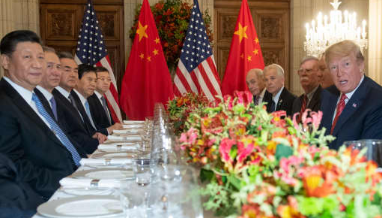- Ameya360 Component Supply Platform >
- Trade news >
- Navarro says Trump's trade strategy may create market volatility, but will be bullish long term
Navarro says Trump's trade strategy may create market volatility, but will be bullish long term

Andrew Harrer | Bloomberg | Getty Images
Peter Navarro, director of the National Trade Council
Current U.S. trade policies may be creating volatility in the near term, but will be good for the markets in the long run, Peter Navarro, one of President Donald Trump's top trade advisors, said Monday on CNBC's "Closing Bell."
In the last year, Trump has opened trade battles on multiple fronts, pressing China, Canada, Mexico and the European Union to come to the negotiating table and imposing tariffs on key imports to get them to take action.
"In the absence of President Trump basically having a tough stance on trade, of setting the standard that trade must be free, fair and reciprocal, we would not have countries talking to us in earnest like they're talking to us now," Navarro told CNBC. "And that's the beauty of the Trump trade strategy. Sometimes it creates a little volatility on the stock markets because the president takes, rightly, strong trade positions."
The Dow Jones Industrial Average hit a record high last week, but it has also swooned several times since the spring as Trump announced new tariffs and raised the pressure on other countries.
"If you're a market investor what you should see is a bullish move toward a structural realignment of a global economy," Navarro said.
The blue chip index fell 181 points on Monday after reports over the weekend that trade talks with China were on shaky ground and reports Monday that Trump's deputy attorney general could be on his way out.
Trump's latest round of tariffs on Chinese imported goods kicked into effect on Monday, and China promised to retaliate in an escalating trade conflict that could jeopardize planned talks between the two sides. Over the weekend, The Wall Street Journal reported that Beijing rejected Washington's invitation to restart talks.
Online messageinquiry

China's Xi is about to deliver a speech that could have major consequences for the trade war

US will hold off on raising China tariffs to 25% as Trump and Xi agree to a 90-day trade truce

Expect a photo op and a 'mock deal' at the Trump-Xi meeting — not a long-term truce, says economist
- Week of hot material
- Material in short supply seckilling
| model | brand | Quote |
|---|---|---|
| BD71847AMWV-E2 | ROHM Semiconductor | |
| MC33074DR2G | onsemi | |
| CDZVT2R20B | ROHM Semiconductor | |
| RB751G-40T2R | ROHM Semiconductor | |
| TL431ACLPR | Texas Instruments |
| model | brand | To snap up |
|---|---|---|
| BP3621 | ROHM Semiconductor | |
| STM32F429IGT6 | STMicroelectronics | |
| ESR03EZPJ151 | ROHM Semiconductor | |
| IPZ40N04S5L4R8ATMA1 | Infineon Technologies | |
| BU33JA2MNVX-CTL | ROHM Semiconductor | |
| TPS63050YFFR | Texas Instruments |
- Week of ranking
- Month ranking
Qr code of ameya360 official account
Identify TWO-DIMENSIONAL code, you can pay attention to


Please enter the verification code in the image below:






















